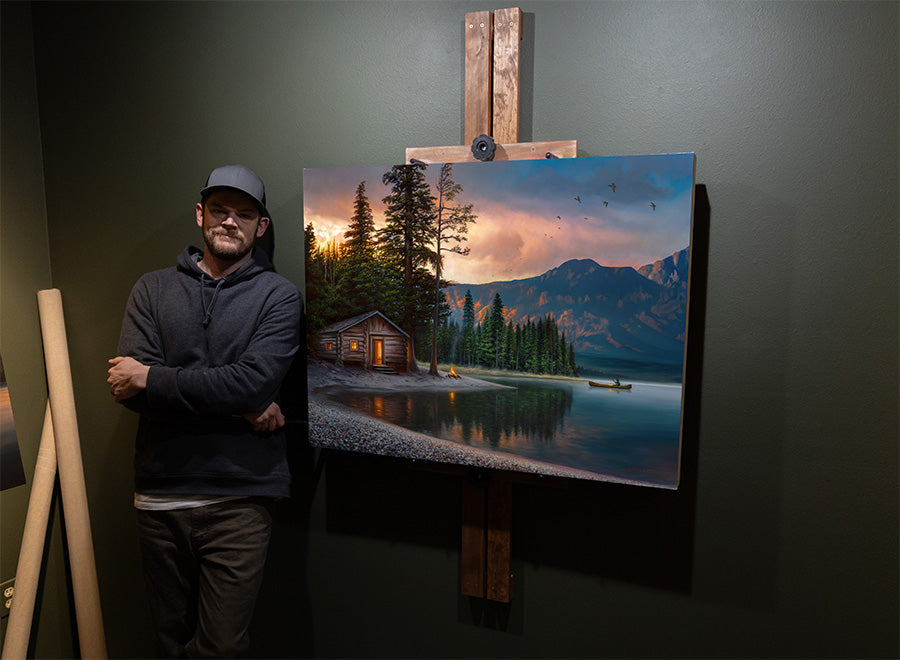This blog is supported through the affiliate links below
Tips For How To Hang Canvas Art: A Step-by-Step Guide
Are you looking to add a touch of elegance and personality to your home decor with canvas art, but unsure of how to hang it? Well, you've come to the right place. In this article, I'll be covering all the tips and tricks that you need to successfully hang canvas art in your home or office, no matter the size or weight. From selecting the right hanging hardware, having the right tools, to measuring and marking your wall, I'll guide you step-by-step through the process. Whether you're a seasoned decorator or just starting out, I'll share the tools you need to create a beautiful and stunning display of your favorite canvas art pieces.

Note: This blog contains affiliate links and purchasing through them supports our site at no extra cost to you.
What do I need to know before getting started?
Hanging canvas art is a relatively easy process and just requires some basic tools and attention to detail. First thing to note is whether your canvas art is framed or not, as the type of framing can impact how the art is hung. Floater framed canvas art is a type of canvas art that is placed within a wooden frame. This type of framing gives the appearance that the canvas is floating on the wall and it's usually hung by a mount on the frame. Unframed canvas art is simply the canvas itself, stretched over a wooden frame and is hung by a mount on the wooden frame. It's also good to have a general idea of the placement, lighting, and safety of the art when hanging.

General tips for hanging canvas art
- Measure the space where the canvas will be hung, and then measure the canvas to ensure it will fit.
- Depending on size and weight (5lbs or more) use a stud finder to locate a stable support in the desired area. If the canvas is too large for the studs or you can't find studs in the desired area, you can use a molly bolt or a toggle bolt. These are heavy-duty anchors that can support a large amount of weight.
- Use a level to ensure the canvas is straight when hanging, this is optional but can be especially helpful when hanging multiple pieces at the same time. If you are hanging multiple canvases, be sure to hang them at the same height and evenly spaced, unless you're doing a gallery style layout.
- If your piece doesn't already come with hanging wire, make sure you install the appropriate poundage picture wire for a secure hold. Remember that when in doubt, go with a higher strength wire.
- Grab the appropriate hanging hardware. Sturdy nails can be used for lighter weight pieces (5lbs or less). Otherwise, use picture hangers that line up with the weight range of your piece. Once you've found the right area on the wall, use your hammer to insert the nail or picture hanger.
- Consider the placement of the canvas in relation to other pieces of art or furniture in the room. Think about whether you want it to be a focal piece or an accent piece and if it goes along with the style that you already have going on in the room.
- Be mindful of the lighting in the room, as different lighting conditions can affect the appearance of the art. Check out my lighting blog post for some helpful tips and important details on how to properly light artwork in your space.
If you are looking for a little more detailed information on hanging canvas wall art keep reading for additional tips and general thoughts.

Measuring your wall for canvas art
Remember that before you hang anything on your wall, you should make sure that the surface is ready to hang art. This means that it should be clean, dry, and free of any defects such as cracks or holes.
-
Start by measuring the width and height of the canvas. Write these measurements down so you can reference them later. If you're hanging your canvas piece over a couch or table, etc you'll want to take those dimensions into account as well.
-
Decide where you want the center of the canvas to be on the wall. Eye level is the most visually pleasing and is pretty standard practice; about around 57" to 60" (inches) from the floor depending on the size. However, you can hang it lower or higher depending on your preference. In general, measure the distance from the floor to the desired center of the canvas and mark it on the wall.
-
Now measure the distance from the top of the canvas to the hanging hardware. If your canvas has a wire or D-ring hanging system, measure the distance from the top of the canvas to the hanging hardware. This measurement is important because it will determine where the top of the canvas will be on the wall as the hanging wire will have some slack.
-
Once you know the distance from the floor to the center of the canvas and the distance from the top of the canvas to the hanging hardware, you can mark the location of where to install the hooks or nails. To do this, measure the distance from the floor to the top of the canvas and add the distance from the top of the canvas to the hanging hardware. This will give you the location of the top of the canvas on the wall.
-
Once you have marked the location of the hooks on the wall, hold the canvas up to the wall to check the placement. Make sure that the center of the canvas is at the desired height and that the top of the canvas is at the marked location. Adjust the placement if necessary.
-
Once you are satisfied with the placement, install the hardware securely on the wall. It's important to note that when hanging a heavy canvas you should use hardware designed for heavy loads and locate the studs in the wall to properly secure the canvas.
-
Finally, use the wire or cord to hang the canvas on the wall. Make sure that the canvas is level and adjust as needed.

What hardware you should install on your canvas
The majority of canvas art pieces should come ready to hang. If for some reason it doesn't or if you'd like to replace the hardware on it here are some suggestions on what to use and their benefits:
Eye hooks and D-rings are the most commonly used as hardware for hanging canvas art. The main difference between the two is in the way they are attached to the canvas.
Eye hooks are small, circular hooks that are screwed into the back of the canvas. They are usually used in pairs, and a wire or cord is passed through both hooks to hold the canvas in place. Eye hooks are a simple and inexpensive option for hanging canvas art, but they may not provide as much support and are not as versatile.
D-rings on the other hand are metal loops that are attached to the back of the canvas using screws or nails. They can be used in pairs or in combination with a wire or cord. D-rings are a more secure option for hanging canvas art, as they can support more weight and provide a more stable hold. They work great for small to large sized canvases.

What to use to hang your piece on the wall
Picture hangers are small, metal J-shaped hooks that can be easily attached to a wall using a hammer and nail. They are designed to hold a single nail in the wall and are good for small to large sized canvases as long as you have the proper weight bearing hanger and hanging wire on the back of the canvas. You can use one or use them in pairs spaced apart for more support or to adjust the height of the canvas.
Sawtooth hangers are similar to picture hangers, but they have a sawtooth-shaped bracket that allows the canvas to be hung on a single nail. The sawtooth hanger is easily attached to the back of a canvas frame with screws. They work well for small to medium-sized canvases.
Z-bar hangers, also known as French cleats, are metal bars that consist of two L-shaped pieces that interlock and provide a very secure hold. One is mounted on the wall and the other is mounted on the back of the canvas or frame, so you'll want to use a level to make sure they are straight. These are a good option for large or heavy canvases.
Overall, the size and weight of your canvas art will determine the hanging hardware you should use. In general, for small and light canvases, picture hangers or sawtooth hangers should be sufficient. For medium-sized canvases, D-rings provide a stable hold and are versatile. For larger and heavier canvases, Z-bar hangers or French cleats may be necessary for a secure hold.

Choosing the right hanging wire
When hanging a canvas, not only is it important to use the mounting hardware rated for the canvas, but it's also important to use the right type of wire for the size and weight of the canvas as they both work together to provide stability to the canvas piece on the wall. Below are some tips and advice to keep in mind when selecting a wire for your canvas:
-
Large or heavy canvases will require more support than smaller ones, so it's important to use a wire that can handle the weight. Look for a heavy-duty wire that is rated for at least the weight of your canvas.
-
Vinyl coated or plastic-coated wire is more durable than regular wire and is less likely to fray, rust, or corrode over time. This is especially important if you plan to hang the canvas in a damp or humid environment.
-
Use adjustable wire for hanging height adjustments: Adjustable wire is a great option if you plan to adjust the height of the canvas in the future. This will allow you to easily adjust the height of the canvas without having to re-install the wire.
-
Use wire with a hook or loop on the end for easy attachment: Wire with a hook or loop on the end makes it easy to attach the wire to a D-ring on the canvas. This can save you time and makes the hanging process much easier. You can also easily make a loop at the end of wire by attaching crimping sleeves, which come with most hanging wires.
When choosing wire for hanging a canvas, keep these things in mind: the size and weight of the canvas, the environment where it will be hung, the thickness of the wire, and if you need an adjustable wire. Know the wire's weight capacity range and if it's rust and corrosion resistant. These factors will help ensure that your canvas is securely and safely hung on the wall to be enjoyed for years to come.
Grow Your Painting Skills and Resources
Instant access to 1000s of royalty-free reference photos of landscapes and wildlife as well as step by step oil painting videos. Checkout My Memberships for more info.

I'm Chuck Black, landscape and wildlife artist based in Southwest Montana.






